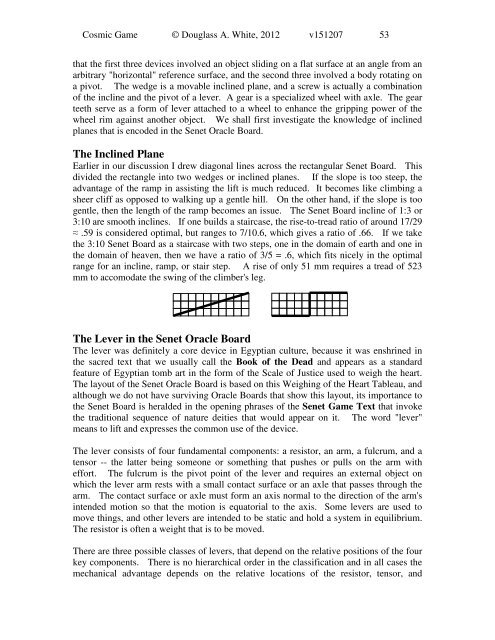You also want an ePaper? Increase the reach of your titles
YUMPU automatically turns print PDFs into web optimized ePapers that Google loves.
<strong>Cosmic</strong> <strong>Game</strong> © Douglass A. White, 2012 v151207 53<br />
that the first three devices involved an object sliding on a flat surface at an angle from an<br />
arbitrary "horizontal" reference surface, and the second three involved a body rotating on<br />
a pivot. <strong>The</strong> wedge is a movable inclined plane, and a screw is actually a <strong>com</strong>bination<br />
of the incline and the pivot of a lever. A gear is a specialized wheel with axle. <strong>The</strong> gear<br />
teeth serve as a form of lever attached to a wheel to enhance the gripping power of the<br />
wheel rim against another object. We shall first investigate the knowledge of inclined<br />
planes that is encoded in the Senet Oracle Board.<br />
<strong>The</strong> Inclined Plane<br />
Earlier in our discussion I drew diagonal lines across the rectangular Senet Board. This<br />
divided the rectangle into two wedges or inclined planes. If the slope is too steep, the<br />
advantage of the ramp in assisting the lift is much reduced. It be<strong>com</strong>es like climbing a<br />
sheer cliff as opposed to walking up a gentle hill. On the other hand, if the slope is too<br />
gentle, then the length of the ramp be<strong>com</strong>es an issue. <strong>The</strong> Senet Board incline of 1:3 or<br />
3:10 are smooth inclines. If one builds a staircase, the rise-to-tread ratio of around 17/29<br />
≈ .59 is considered optimal, but ranges to 7/10.6, which gives a ratio of .66. If we take<br />
the 3:10 Senet Board as a staircase with two steps, one in the domain of earth and one in<br />
the domain of heaven, then we have a ratio of 3/5 = .6, which fits nicely in the optimal<br />
range for an incline, ramp, or stair step. A rise of only 51 mm requires a tread of 523<br />
mm to ac<strong>com</strong>odate the swing of the climber's leg.<br />
<strong>The</strong> Lever in the Senet Oracle Board<br />
<strong>The</strong> lever was definitely a core device in Egyptian culture, because it was enshrined in<br />
the sacred text that we usually call the Book of the Dead and appears as a standard<br />
feature of Egyptian tomb art in the form of the Scale of Justice used to weigh the heart.<br />
<strong>The</strong> layout of the Senet Oracle Board is based on this Weighing of the Heart Tableau, and<br />
although we do not have surviving Oracle Boards that show this layout, its importance to<br />
the Senet Board is heralded in the opening phrases of the Senet <strong>Game</strong> Text that invoke<br />
the traditional sequence of nature deities that would appear on it. <strong>The</strong> word "lever"<br />
means to lift and expresses the <strong>com</strong>mon use of the device.<br />
<strong>The</strong> lever consists of four fundamental <strong>com</strong>ponents: a resistor, an arm, a fulcrum, and a<br />
tensor -- the latter being someone or something that pushes or pulls on the arm with<br />
effort. <strong>The</strong> fulcrum is the pivot point of the lever and requires an external object on<br />
which the lever arm rests with a small contact surface or an axle that passes through the<br />
arm. <strong>The</strong> contact surface or axle must form an axis normal to the direction of the arm's<br />
intended motion so that the motion is equatorial to the axis. Some levers are used to<br />
move things, and other levers are intended to be static and hold a system in equilibrium.<br />
<strong>The</strong> resistor is often a weight that is to be moved.<br />
<strong>The</strong>re are three possible classes of levers, that depend on the relative positions of the four<br />
key <strong>com</strong>ponents. <strong>The</strong>re is no hierarchical order in the classification and in all cases the<br />
mechanical advantage depends on the relative locations of the resistor, tensor, and





